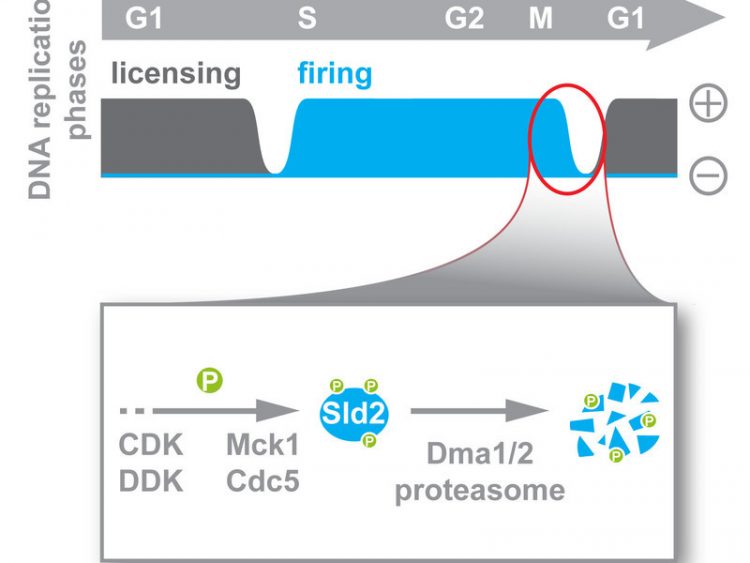DNA Replication – Take a break

Sld2 divides two phases (licensing and firing) of DNA-Replication from one another and is thereby a crucial control factor. Sld2 needs to be switched off by the enzymes Dma1 and Dma2 until the cell starts a new DNA-duplication. The DNA is more vulnerable for errors if this break is missing.
large-scale projects are frequently susceptible to errors and these are generally very cost-intensive. A cell’s most important large-scale project is the replication of its DNA, i.e. the complete duplication of its genetic material. Here, errors such as the inadvertent multiplication of a DNA sequence can change the structure of the chromosomes.
This can lead to cell death or, in the case of multi-cellular organisms such as humans, to the development of cancer. For this highly important project, the cell increases its success rate by dividing the process of DNA replication into a planning phase, known as the “licensing” phase, and an implementation phase, known as the “firing” phase.
The two phases follow in sequence. Boris Pfander, head of the “DNA Replication and Genome Integrity” research group, and his team have demonstrated that the baker’s yeast S. cerevisiae separates the timing of these phases from one another and that the Sld2 protein plays an important role in this regulation.
“A crucial factor in the success of the DNA duplication project is, on the one hand, that project planning is completed before the building work begins, but also that no new plans are made while the actual building work is being carried out,” Pfander explains.
The Martinsried-based team has shown that the cell, at the transition between the implementation phase and the next planning phase, first switches off all building machines (firing factors) – first and foremost, the Sld2 building machine. The correct time for switching off Sld2 is determined by four different kinase enzymes called CDK, DDK, Mck1 and Cdc5, which mark Sld2 with phosphate molecules. When all four enzymes have phosphorylated Sld2, the enzymes Dma1 and Dma2 become active and ultimately switch off Sld2.
If Sld2 is not switched off on time, the cell loses some of its valuable break time. In these circumstances, the DNA can still reliably duplicate, but it is vulnerable to the occurrence of sporadic errors. This means that it is not only important that cells take breaks, but that the length of these breaks is sufficient. “We now want to look for similar important breaks in other multi-cellular organisms,” says Pfander. “The division of the firing and licensing phase helps to counteract genomic defects. We can imagine that cancer cells do not take sufficient breaks, and that our research will help gain a better understanding of the development of cancer.”
Original publication:
K.-U. Reusswig, F. Zimmermann, L. Galanti and B. Pfander: Robust replication control is generated by temporal gaps between licensing and firing phases and depends on degradation of firing factor Sld2. Cell Reports, October 2016
DOI: 10.1016/j.celrep.2016.09.013
Contact:
Dr. Boris Pfander
DNA Replication and Genome Integrity
Max-Planck-Institute of Biochemistry
Am Klopferspitz 18
82152 Martinsried
Germany
E-Mail: bpfander@biochem.mpg.de
www.biochem.mpg.de/pfander
Dr. Christiane Menzfeld
Public Relations
Max Planck Institute of Biochemistry
Am Klopferspitz 18
82152 Martinsried
Germany
Tel. +49 89 8578-2824
E-Mail: pr@biochem.mpg.de
http://www.biochem.mpg.de/en/news – More press releases of the MPI of Biochemistry
http://www.biochem.mpg.de/pfander – Website of the Research Group “DNA Replication and Genome Integrity” (Boris Pfander)
Media Contact
More Information:
http://www.biochem.mpg.de/All latest news from the category: Life Sciences and Chemistry
Articles and reports from the Life Sciences and chemistry area deal with applied and basic research into modern biology, chemistry and human medicine.
Valuable information can be found on a range of life sciences fields including bacteriology, biochemistry, bionics, bioinformatics, biophysics, biotechnology, genetics, geobotany, human biology, marine biology, microbiology, molecular biology, cellular biology, zoology, bioinorganic chemistry, microchemistry and environmental chemistry.
Newest articles

Silicon Carbide Innovation Alliance to drive industrial-scale semiconductor work
Known for its ability to withstand extreme environments and high voltages, silicon carbide (SiC) is a semiconducting material made up of silicon and carbon atoms arranged into crystals that is…

New SPECT/CT technique shows impressive biomarker identification
…offers increased access for prostate cancer patients. A novel SPECT/CT acquisition method can accurately detect radiopharmaceutical biodistribution in a convenient manner for prostate cancer patients, opening the door for more…

How 3D printers can give robots a soft touch
Soft skin coverings and touch sensors have emerged as a promising feature for robots that are both safer and more intuitive for human interaction, but they are expensive and difficult…





















